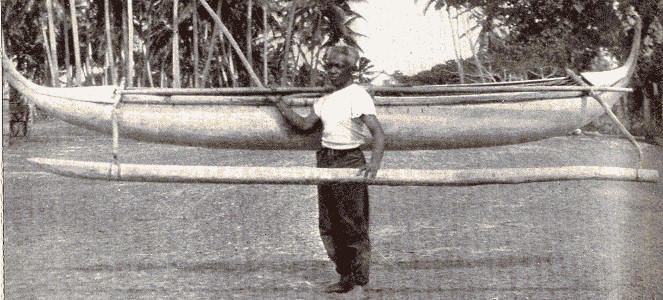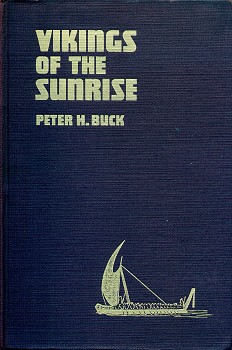 |
surfresearch.com.au
buck : vikings of the sunrise, 1938 |
| home | catalogue | history | references | appendix |
|
For an online edition
(with four maps, but unfortunately without the illustrations), see:
http://www.nzetc.org/tm/scholarly/tei-BucViki.html
New Zealand Electronic
Text CentreTe Rangi Hiroa
Title: Vikings
of the Sunrise
Author: (Sir
Peter Henry Buck) Te Rangi Hiroa
New Zealand Edition
Publication details:
Whitcombe and Tombs Limited, 1964
Part of: New Zealand
Texts Collection
This text is the
subject of: Victoria University of Wellington Library Catalogue
Page 119
Chapter X
The Northwest
Atolls
...
Both Manihiki
and Rakahanga are small atolls whose islets are set on a coral reef encircling
an inner lagoon.
Neither atoll
has openings through the reef which will admit canoes.
In order to land
and to discharge cargo, the schooner lays off as close to the reef as is
safe, and passengers and cargo are transhipped into outrigger canoes.
The old type
of canoe has completely disappeared and a modern form is made from imported
sawn timber.
Though shaped
like a flat-bottomed boat with sharp bow and stern, the outrigger is retained.
The natives paddle
in close to the reef and wait patiently until the right wave comes surging
along.
They paddle vigorously,
the wave lifts the canoe over the outer lip of the reef, and, if deep enough,
floats it across the reef into the outer lagoon that stretches between
the reef and the shore.
If the wave is
too shallow, the canoe grounds on the reef; the crew leap out and hold
the canoe to prevent it from being drawn back by the suction of the receding
wave.
As the wave subsides,
one may gaze fearfully down the vertical outer side of the reef and into
the yawning, gurgling chasm below. The newcomer is not reassured by tales
of people who have been sucked down into coral caverns from which they
never reappeared.
Page 120
Large timber was
scarce, and before the introduction of sawn timber, the two kinds of trees
suitable for canoes were split into planks so as not to waste any material
by dubbing out trunks as hulls.
The tools, as
already mentioned, had to be made from tridacna shells, owing to the lack
of basaltic stones.
Clothing had
to be made from coconut leaves or plaited pandanus leaves, for the paper
mulberry which provided elsewhere the raw material for bark cloth does
not grow on atolls.
Even firewood
was scarce; coconut shells, dry coconut husks, and the dry sheaths and
racemes of coconut flowers were collected for the cooking fires.
Page 131
 |
Bishop Museum |
Correct is the
explanation, wrong is the lore,
Correct is the
lore, wrong is the explanation.
Correct, correct
is the lore,
Ah, no!
It is wrong,
it is wrong - alas!
Page 230
Chapter XVII
The Apex of the
Triangle
...
Easter Island
has little fertile soil and no forests with large trees to provide adequate
raw material for houses and canoes. Consequently the framework of houses
was made of slender arched poles, and houses were narrow, low, and long.
In order not
to waste valuable inches, the poles were not stuck in the ground but rested
in holes carved out of stone blocks.
These pitted
curbstones, like the elaborate bird cult, are unique on Easter Island,
evolved locally due to lack of timber.
The canoes were poor and flimsy, but ten to twelve feet long and formed of many small bits of wood sewn together.
Page 231
Even the paddles
were made of two pieces: a short, narrow blade with a separate handle lashed
to it.
The two-piece
paddle is unique for Polynesia, but again the form of the canoe and paddle
was a local adjustment forced upon the people by the lack of material.
Successive European
voyagers saw fewer and fewer canoes on Easter Island, not because of degradation
in the population, but because of constant decrease in the wood supply.
The people swam
out to ships sometimes with a supporting float formed of a conical bundle
of bulrushes.
Wood was as precious
as gold in Europe or jade in New Zealand.
The minimum quantity
was used for necessities, and the surplus constituted wealth in the form
of wooden breast ornaments, dance implements, and carved tablets.
Macmillan Brown
in his work on "Peoples and Problems of the Pacific" condemned the arts
and crafts of Easter Island as being the most primitive in Polynesia.
This is manifestly
inaccurate and unfair.
Apparently he
did not take into consideration the vast importance of environment and
its influence on all forms of material culture. The feather headdresses
of Easter Island compare favorably with those of the Marquesas and Tahiti
and are vastly superior to any similar work in Samoa and Tonga.
The bark cloth
is remarkable, for the shortcomings of the original material are overcome
by quilting with threads by means of a bone needle.
The carving of
wooden ornaments, stone images, and the development of decorative techniques,
such as the representation of eyes by means of a shell ring with a black
obsidian pupil, are among the most remarkable in all Polynesia.
Brown has condemned
the Easter Islanders for not making greater use of bone, turtle shell,
and obsidian to inlay their wood carvings, but neither did the other great
branches of the Polynesians.
The most unfair
criticism is leveled at the implements, which are classed as childish.
Page 276
Chapter XIX
The Southern
Angle
...
One must be saturated
with the atmosphere of tropical Polynesia to fully appreciate what the
first Maori settlers lost and what they gained in their new country.
They lost certain
prolific food plants, and somehow the pig and fowl were left behind or
died on the voyage.
The dog alone
of three Polynesian domesticated animals landed in New Zealand.
The Polynesian
name of the fowl, moa, was evidently applied to a large wingless
bird which became extinct.
The forests teemed
with bird life and new processes were invented for catching, preserving,
and storing.
The decoy water
trough, the carved snare, the bone-pointed bird spear, and receptacles
for preserved pigeons are all local developments not known elsewhere in
Polynesia.
The rivers, lakes,
sea beaches, rock reefs, and the sea all provided a supply of food that
more than made up for the cultivable foods that would not grow in the cold
climate.
The greatest wonder
of all must have been the forest trees that grew larger than any others
in Polynesia.
The canoe builders
must have gazed awestruck at the great trunks of the totara and
the kauri pine.
I can see them
offering up a ...
Page 277
... ritual formula
to Tane and spanning the tree trunk with admiring arms.
As practical
geologists, they must have enjoyed cracking and testing rock until the
best basalt indicated where adz quarries should be located.
With larger and
heavier adzes, the forest giants were felled and dubbed into canoe hulls.
The dugouts could
be made so wide that they floated like boats without need of a side prop,
and so the out-rigger attachment was abandoned.
...
In addition to
a rich supply of basaltic stone, New Zealand gave her settlers the gift
of jade.
It was found
as boulders in the rivers of the west coast of the South Island, and that
island consequently received the name of Te Wai-pou-namu (Water-containing-jade).
Jade was used
to make ornaments and short war-clubs that became priceless heirlooms,
but more wonderful were the chisels and adzes that took an edge almost
as keen as steel.
The totara
timber
was durable but soft, and with good wood and excellent tools, the Maori
carvers developed a craft into an art that was unique not only for Polynesia
but for the Pacific.
Chapter XX
The Base of the
Triangle
Page 288
Turning to traditions,
we find that there are no tale of long sea voyages.
Percy Smith believed
that the Polynesians reached Samoa in about 450 A.D.
Whenever it was,
the Samoans have been so long in residence that, like the Tahitians, the
records of the first ancestors who came by ship have been overlaid by the
mass of succeeding events.
The theory of
a local origin from worms is a mythical substitution for forgotten human
history.
In place of voyages
by canoe, there are myths of long-distance swimming.
An ancestor named
Vi swam from the Tokelau group to Tau, a distance of over 300 miles.
I was ...
Page 289
... shown the
rock that represented his petrified body.
Two women named
Taema and Tilafaiga swam back to Samoa from Fiji, where they were supposed
to have observed the Fijian custom of tattooing the women but not the men.
Owing to their
long immersion in the sea, they landed in Samoa shivering with cold and
through chattering teeth they delivered the following inverted message:
When the men grow
up, tattoo them.
When the women
grow up, let them bear children.
 |
Vikings of the Sunrise J.B. Lippincott & Co, Philadelphia, 1938 Frederick A.Stokes Company, New York U.S.A., 1938. |

| home | catalogue | history | references | appendix |